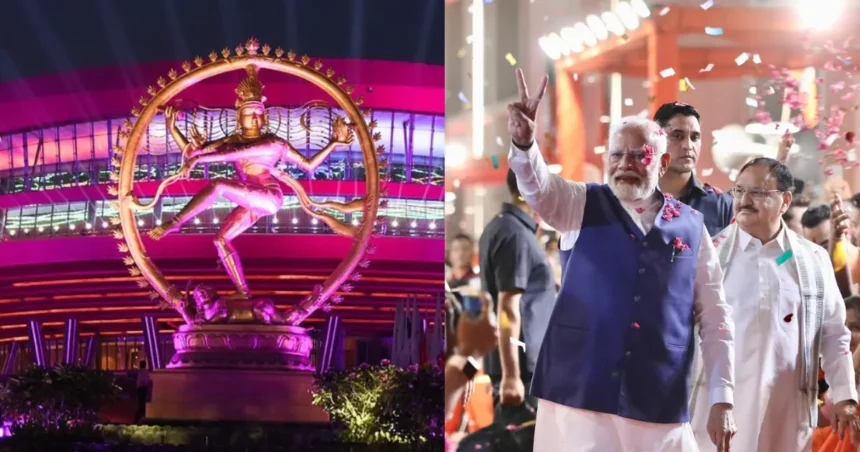The recent Indian parliamentary elections yielded unexpected results, leaving the incumbent Bharatiya Janata Party (BJP) with a weaker electoral victory than anticipated. Prime Minister Narendra Modi secured his third consecutive term, albeit with a slim majority. While 272 seats are required for a majority, the BJP managed to secure only 240 seats, relying on coalition partners to form the government.
Despite the political dynamics, India foreign policy is unlikely to witness significant shifts. Let’s delve into the key aspects of India’s foreign relations under Modi’s third term:
India foreign policy in new NDA government: Pragmatic Approach towards China
Historically, the BJP was critical of China, advocating for Tibet’s independence. However, as the party mainstreamed, its tone softened. In 2014, the BJP manifesto didn’t even mention China, focusing instead on strengthening the Line of Actual Control (the disputed boundary).
Narendra Modi’s informal summits with Chinese leader Xi Jinping yielded no substantial results, and tensions escalated in 2017 during the Doklam standoff. Surprisingly, the 2019 manifesto took an even softer stance on China, emphasizing dialogue and cooperation.
Experts emphasize the need for deeper engagement with China beyond border management. Trade balance, strategic intentions, and India’s dependency on Chinese industries are critical factors.
US and Russia Ties: Expanding Horizons
Experts predict that under Narendra Modi’s third term, India will continue to enhance ties with major powers, including the United States and Russia. The goal is to position India as a global friend (or “Vishwa Bandhu”) and strengthen strategic partnerships.
India’s relationship with Russia has traversed complex terrain, influenced by geopolitical shifts and strategic imperatives.
External Affairs Minister S. Jaishankar’s recent visit to Moscow marked a turning point. After two years of cautious engagement, India signaled a renewed commitment to its historical ally.
India’s ties with Russia have been transactional lately, driven by energy trade (oil and coal) and defense cooperation. However, Moscow’s declining international standing and India’s growing alignment with other powers pose challenges.
Balancing these interests remains critical. India seeks to enhance global ties while maintaining its historical partnership with Russia. Russia’s evolving role in the Indo-Pacific and Eurasia impacts India’s calculus. Moscow’s ties with China and Pakistan are closely monitored.
India aims for a multipolar world order, engaging with both Russia and the United States. India’s pragmatic approach navigates the complexities of a changing world, preserving its strategic interests while adapting to new realities.
The India-USA relationship significantly influences regional stability in several ways. India’s strategic partnership with the U.S. acts as a counterbalance to China’s growing influence in the Indo-Pacific region. By aligning with India, the U.S. aims to maintain stability and prevent any single power from dominating the region.
Joint military exercises, intelligence sharing, and defense technology collaboration enhance regional security. The U.S. supports India’s role in securing sea lanes and maintaining stability in the Indian Ocean. Trade and investment between India and the U.S. contribute to economic stability. Bilateral trade agreements and technology partnerships foster growth and resilience.
India’s close ties with the U.S. provide diplomatic leverage in multilateral forums too. Cooperation on global challenges (climate change, terrorism, etc.) strengthens regional stability.
Coalition Government and Foreign Policy Challenges
With no single party securing a Lok Sabha majority for the first time in a decade, experts believe that the coalition government won’t hinder India’s foreign policy objectives. Key challenges include engaging with China and managing ties with Pakistan.
After a decade of single-party rule, India’s political landscape is once again embracing coalition politics. The recent election results have left the Bharatiya Janata Party (BJP) as the largest party but without an outright majority in the Lok Sabha. As Prime Minister Narendra Modi navigates this new terrain, he faces the intricate web of “coalition dharma,” a term coined by former Prime Minister Atal Bihari Vajpayee.
The Historical Context
India has a rich history of coalition governments. For 32 out of the country’s 71 years of electoral journey, coalition politics has been the norm. Let’s rewind to 1977 when Independent India witnessed its first coalition government—the Janata Party alliance, which included the predecessor of the BJP. This rainbow coalition governed until 1979.
The Tightrope Walk
Heading a coalition government is akin to walking a tightrope. It requires delicate balance and adept negotiation skills. Atal Bihari Vajpayee, the first non-Congress Prime Minister to complete a five-year term, exemplified this art. His tenure showcased how to manage irate coalition partners, including the fiery Mamata Banerjee. In scenarios without a single-party majority, regional parties become kingmakers. Their support shapes national policies within coalition governments.
The Modi Era and New Challenges
Narendra Modi’s previous governments enjoyed brute majority rule, allowing the BJP to govern without appeasing coalition partners. However, the current scenario demands a different approach. While the BJP remains the largest party, it falls short of the magic number—272 seats—needed for an independent government. Modi, who has never needed a crutch since his early days in Gujarat, now faces the intricacies of coalition politics.
The Key Features of Coalition Politics
- Temporary Conjunction of Interests: Coalitions emerge from the temporary alignment of specific interests. Pragmatism trumps ideology, and compromise becomes essential.
- Minimum Programme: Unlike idealistic platforms, coalitions operate on a minimum common agenda. Each partner may need to set aside principles for the sake of power.
- Pre-Poll vs. Post-Election Coalitions: Pre-poll alliances allow parties to present a joint manifesto to voters. Post-election coalitions enable constituents to share power and run the government. India’s myriad cultures and identities find a voice through regional parties. By championing regional interests, they contribute to inclusive governance. Born from specific regional challenges, these parties bring grassroots concerns to national politics. This enriches the policy framework on a good note.
Conclusion
As India embarks on this new chapter of coalition governance, the nation watches closely. Will Modi follow in Vajpayee’s footsteps? Only time will reveal the delicate dance of coalition politics and the challenges it brings. One thing is certain: “Coalition dharma” is back, and India’s political landscape is richer for it. While political realities may shape domestic narratives, India foreign policy remains steady under Modi’s leadership. As the nation navigates regional complexities and global dynamics, continuity and pragmatism define its approach.










